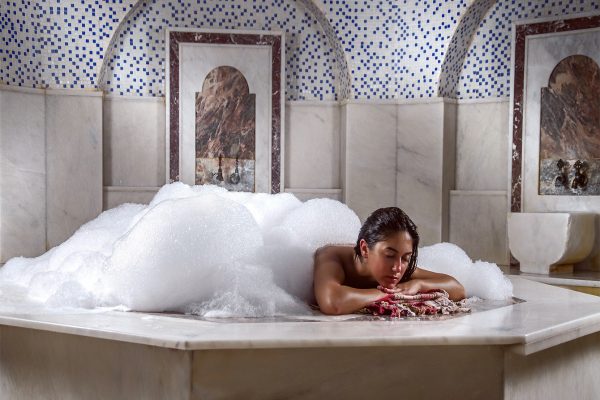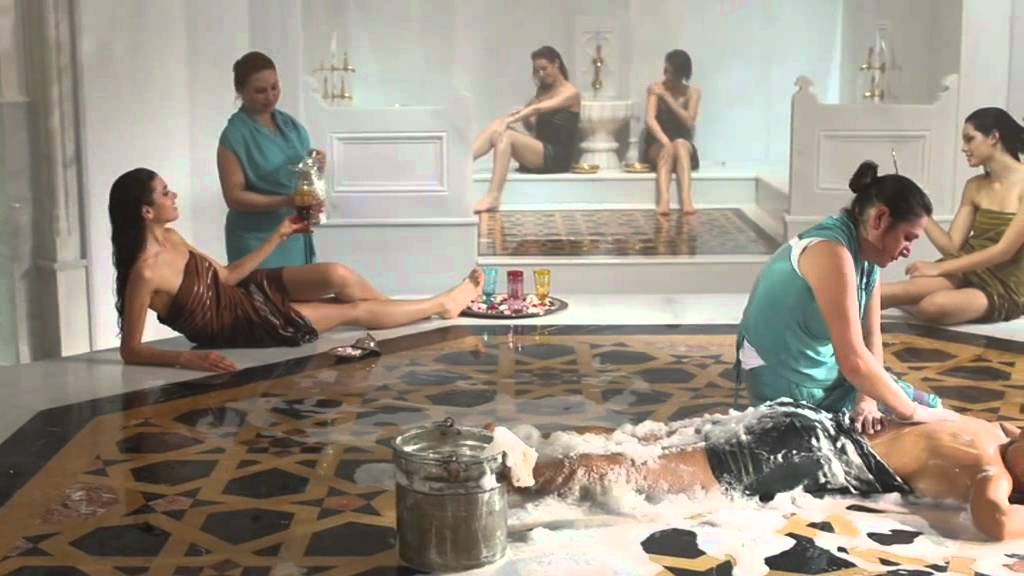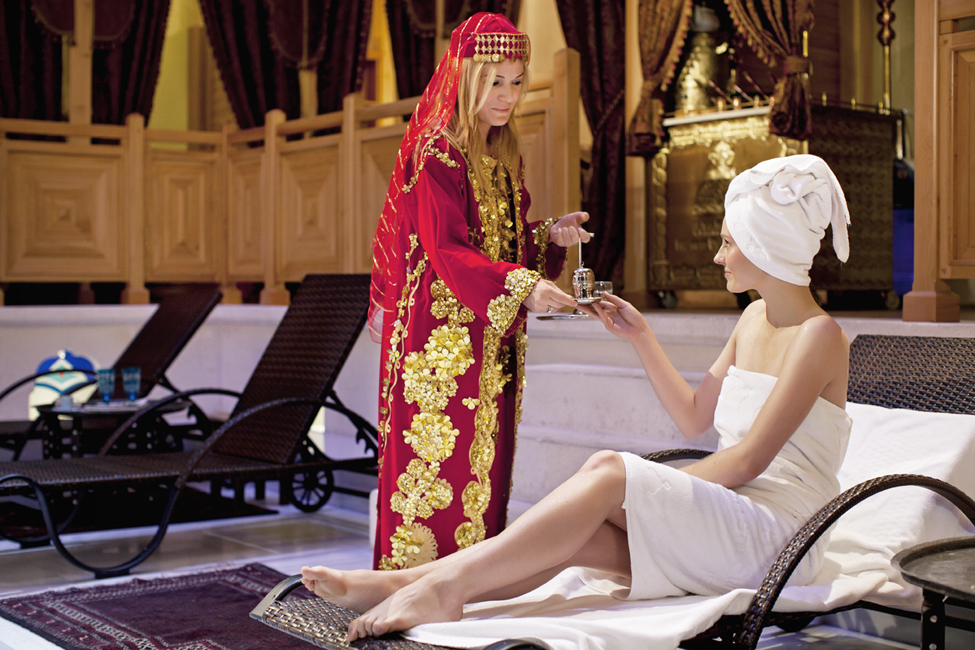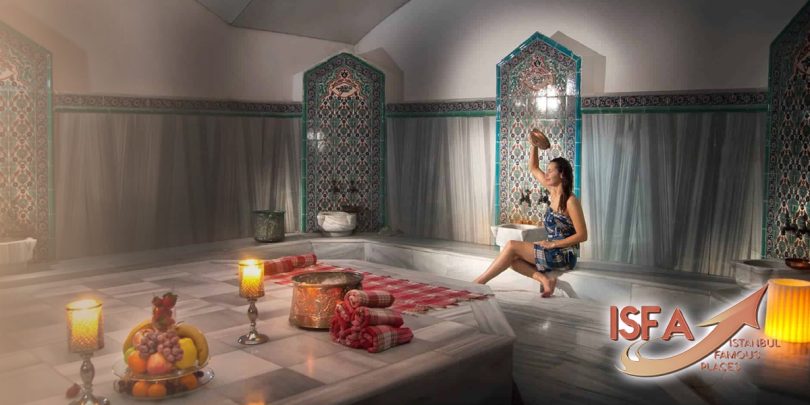What is Turkish bath?
Traditional Turkish bathing has been carried out for generations in Turkey and other regions of Central Asia, North Africa, and the Middle East. This bathing ritual is also known as a Hammam. A cultural and social event, it incorporates purification, relaxation, and meeting new people.
While most traditional Turkish bath include male and female sections, some more contemporary ones may have private or mixed-gender alternatives. There are often many rooms or chambers in the bathroom, and they all have a distinct function.

The first chamber is filled with steam and is heated; it is called the sıcaklık or hot room. In this heated setting, guests may relax, scrub their skin, and open their pores while perspiring. Typically, marble seats or platforms are made available for relaxation.
After a session in the hot room, bathers transition to the ılıklık, also known as the warm room, to relax and calm off. As a transitional space between the hot and cold rooms, this one is often less humid. This is the perfect spot for a refreshing rinse before continuing to soak.
The soğukluk, also known as the chilly chamber, is the last part of a traditional Turkish bath. Cooling down in this room is a welcome change from the hotter ones that came before. People who go swimming often use cold water splashes or even submerge themselves in pools of cold water to stimulate their senses.
While in the bath, guests have the option to have a traditional scrub and massage performed by a male attendant called a tellak or a female attendant called a natır. The attendants will use a kese, a kind of exfoliating glove, to cleanse the skin of dead cells and pollutants, resulting in smooth, revitalized skin.
In addition to its medicinal and purifying properties, the Turkish bath is a popular meeting spot for individuals of all walks of life, where they can unwind, make new friends, and generally have a good time. Both Turks and foreigners appreciate it for what it represents of Turkish culture.
The tradition of hammams or baths, as we might call them today, is as old as the Neolithic age. They are not much different from the concept of community baths but hold a religious significance. Strange as it might seem, these hammams were also a place for social gatherings.
And often, a reason for a divorce should a woman not be given the right to go to a hammam, some sources claim. Though Turkish Baths have lost significance today, the old glamor still prevails in many Turkish cities.

A glimpse of the history of Turkish baths
The concept of hammam originated in the Neolithic period, and the oldest trace is in Pakistan called “The Great Bath.” But it was in the Roman period when community baths became prominent. These baths played a crucial role in social interactions between members of the Roman community.
With time these baths expanded and turned an inseparable part of people’s lives. But not for long as modernization and other revolutions weekend the community bath culture. Religious movements were also behind the closure of such community bath practices.
Moreover, Turkish baths are a transition from traditional Roman baths. Unlike Roman baths, where there were pools of water and people used to bathe together, Turkish hammams have no pools. Probably because they believed it was unhygienic to take a bath in still water. Another ideology is that Turkish baths negated the use of water pools as it was against the ways of bathing in Islam.
Turkish baths have gained immense popularity, and despite losing their ancient significance, people still prefer the hammam today. Turkish bath houses are all over the country. The most significant ones are in Istanbul, the city of lights.

Marble flooring and countertops, water sinks and faucets, and steam; a heated room for bathing and healing describes a classic Turkish bath. It is all about the ambiance that heals you from inside and out. The Turkish bath massage forms a vital part of the bathing experience.
Purely associated with the Islamic world, these baths are favorites of tourists who come to the Middle East, especially Turkey, just to have the bathing experience. So for those looking for answers to the question ‘what is a Turkish bath” nothing can explain than experiencing it oneself.
The process of Turkish Bath
Getting ready for Turkish Bath
After undressing in a “halvet” (changing room) and wearing a “peştamal” (thin towel) and “takunya” (wooden sandals), you enter “hararet” (steam room).
Traditional Turkish hammams are not unisex, as it is against the culture and the basic idea of bathing.
You will join others in the steam room, semi-naked, where you’ll let your body sweat. The idea behind this is to open the pores. These steam rooms are similar to Turkish spas but are much more beneficial. You will sit on a göbek taşı, a special heating stone, which also helps the body to relax.
Complete body exfoliation
After enough sweating, you will lie down on a center marble countertop, where an attendant will start the exfoliating process.
Hammams are made of special göbek taşı. These are marble countertops warm to the touch. As you lie down on the stone wearing your peştamal, the attendant will use traditional coarse mitts to scrub your back and body.
What we expose our bodies to has a direct impact on our well-being. Our skin breathes, and a natural and clean environment makes up for a relaxing experience.
As your body rests on the göbek taşı, your body responds well and heals. It feels similar to a spiritual experience.
Lathering and massage stage
Using organic soaps, the person will form a lather on your body. Clouds of bubbles and lather will cover you from bottom to top. It becomes fun when that starts to happen.
Turkish people like homemade, organic soaps. Besides a variety of soaps made out of rose, lavender and jasmine, you can also find soap bars made of orange, lemon peels, donkey milk, goat milk, tea, blueberry, and more.
Donkey milk soap has exceptional benefits; it rejuvenates the skin and helps to get rid of dead skin. For those wanting shiny and fragrant skin, go for orange or rose soaps. You can take one with you, easily available in a Turkish market, or asks the hammam to provide you.
The silky smooth touch actually becomes therapeutic. Your attendant will massage you, helping the stiff muscles of your body to relax. Turkish bath massage has gained a name for itself. The massage is not the ordinary massage you might think. It is pretty heavy, and you feel it on your back and legs, the way the stiffness of your muscles relax.
Hair shampooing and head massage
The attendant will gently shampoo your head and massage it at the same time. In the case of women, the attendant will also gently wet your hair with trickling warm water and clean the hair of dirt with soap.
Some people also prefer shampoo, which you can bring with you. Traditional Turkish hammams will use bath soaps instead due to their medicinal benefits. These soaps are not rough and so they will leave your hair well-nourished and shiny.
Washing and drying
After a good session of massage and lather covering your body, it is time to wash it off. The attendant throws buckets of water on you to wash off the foam. After a good rinse, the attendant will use towels to dry your skin thoroughly. The last bit will be moisturizing your skin with essential oils, which is optional.
A traditional Turkish bath takes up to four to five hours. You will be served nice hot Turkish tea in tulip-shaped glasses, symbolic of Turkish culture, with some snacks too.
It is a complete self-pampering experience. Apart from the benefits of steam, exfoliation, massage, and essential oils, which work wonders for the skin, Hammam is also therapeutic. Hammam once a month is enough to relax your body from stress and daily workload.
The 5 Best Turkish Hammams in Istanbul
Ayasofya Hürrem Sultan Hamamı
Hurrem Sultan, the wife of Ottoman Sultan Süleyman the Magnificent, commissioned this 16th-century Turkish hammam in Istanbul. Named after Hurren herself, Ayasofya Hürrem Sultan Hamamı speaks volumes about ancient history.
Besides it also takes you down the historical lane with its magnificence and an experience that mere words can’t express. Designed by the famous Mimar Sinan. the hammam has survived to this day and is simply terrific.
Located in Istanbul’s Fatih district, another tourist attraction, the package starts from 750 to 1,000 Turkish liras.
Ağa Hamamı
Located on Turnacıbaşı street in Taksim Square, Istanbul’s famous landmark, Ağa hamamı is one of the oldest known Turkish baths. Built on the orders of Fatih Sultan Mehmed the Conqueror, the hammam was for his personal use. Abdulmecid, the 31st Ottoman sultan, later ordered the renovation of the hammam, which the kings and their sons used until the end of the Ottoman Empire.
Ağa hamamı is a vintage example of Islamic architecture. Being one of the first hammams in Istanbul, Ağa’s interiors are basic with a classic feel. Its simplicity is what attracts people the most, and today has become a center of attraction in the West.
The price range of Ağa hamamı starts from 1,000 Turkish Liras and can go higher according to the services you choose.
Cağaloğlu Hamamı
Cağaloğlu Hamam was one of the last major hammams constructed in Istanbul during the Ottoman period. Lying in Istanbul’s heart, Fatih, the hammam also adorns beautiful interiors.
It is a double hammam with separate sections for men and women. The architecture reflects Ottoman and Baroque styles, which makes it unique and worth the visit.
Today the hammam offers much more. It has also become a tourism hotspot, offering beauty treatments to body relaxation and massages. The price starts from 50 euros and goes up depending on the service packages. It is indeed the best Turkish bath in Istanbul.
Kılıç Ali Paşa Hamamı
If we are talking about the best hammam in Istanbul, we can’t miss out on Kılıç Ali Paşa Hamamı. In addition to the grandeur and ambiance, the hammam’s architecture express the Ottoman lifestyle marvelously. Surrounded by white, the experience at the hammam truly becomes spiritual.
The experience becomes more than one could ask for, as the Turkish bath gives a feeling of calmness and pleasure. At Kılıç Ali Paşa Hamamı, you get to experience the complete hammam ritual just the way it traditionally should be.
Located in Istanbul’s Beyoğlu district on the European side, this historical hammam offers services starting from 960 Turkish Liras.
Süleymaniye Hamamı
Facing the golden Horn and located in Istanbul’s Fatih district, Süleymaniye Hamamı forms part of the famous Süleymaniye Mosque complex.
The hamam takes its name after Sultan Süleyman the Magnificent, as he commissioned it. Furthermore, Mimar Sinan, the greatest architect of all time, constructed Süleymaniye Hamamı.
The hammam has stunning marble inlays adorning its walls, too. Exuding beauty from all its corners, it is worth the money spent. It is also a perfect example of a traditional Turkish bath in Istanbul.

